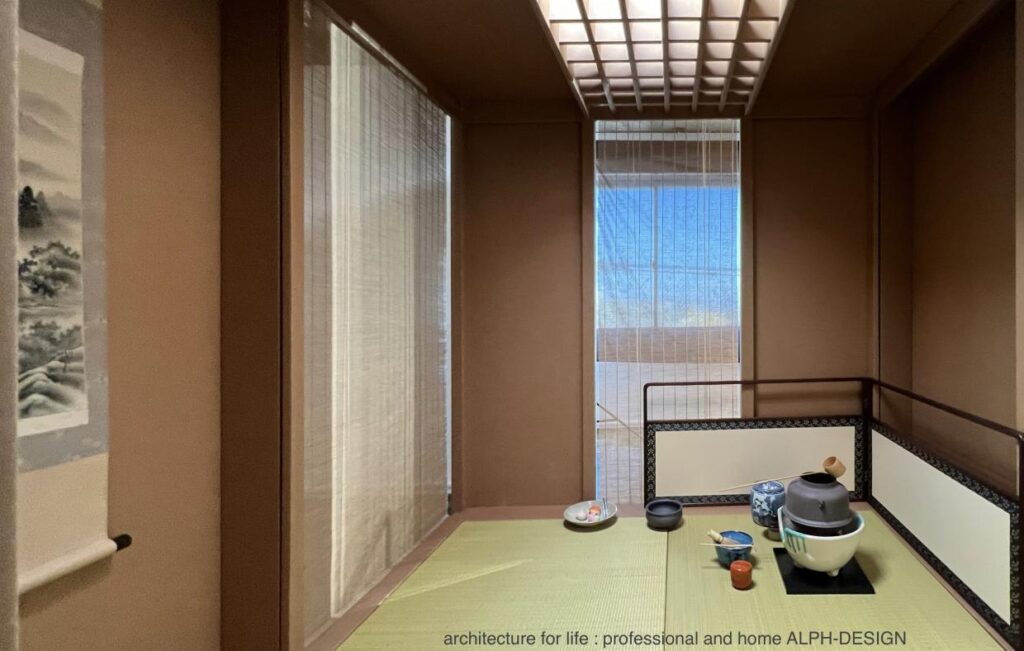紙日庵

茶室「紙日庵」について
千利休が茶道を体系化するよりも100年前、室町時代の茶人、村田珠光は「茶禅一味」と茶の湯を表現しました。其れは、「茶の湯は禅に通ず!」と言う茶の精神を表したものです。
その後「茶禅一味」の精神は、武野紹鴎へと受け継がれ「侘」と言う空間思考へと繋がります。
珠光は2帖やせいぜい3帖程度の小空間に於いて、俗世から切り離された大きな宇宙を表現する手法を模索しました。その精神はその後、武野紹鴎から千利休へと受け継がれ「侘数寄」の世界へと広がります。その精神は今も根強く日本人の生活習慣や価値形成の根底にあり、其れが日本特有の文化を形成するものだと考えます。
当時、多くの大名や貴族達が好んだ黄金の舶来装飾品に対し、自然界にあるもので構築された質素でありながらも匠の技を用い、俗世(人の欲望)から一線を画した価値を、珠光は禅の思想から導きました。
清楚で美しく均整の取れたミニマム空間で精神を清め、茶の湯を頂く日本特有の文化が其処に誕生しました。
紙のパネル材で構築した「紙日庵」は、本来お茶室に設けられていた中柱や袖壁等の造作を無くしています。また蓮子窓、下地窓や躙口、茶道口等の開口部ついては、紙のパネルによる構造体間の隙間に集約してしまい、物も人も出入可能とした開口部として室内四方向其々に設けました。
また其れ等の開口部に簾を垂らす事で、内部空間と外部空間の繋がりを視覚的に曖昧にしています。天井は中央部を格子状として開放。設置される建物の防災設備に対応できるよう、また建物全体からの照明光が入るような配慮からです。室内四方にある開口部及び天井格子によって「紙日庵」内部の空気環境が開放されている事で、新たな消防設備や空調換気設備などの設備を不要としています。
一畳台目の茶室には、江戸初期、千利休の孫、千宗旦により京都に造られた究極の一畳台目茶室「今日庵」があります。二帖間の間取は大きさが限られるのでどうしても似てしまいますが「紙日庵」では畳は縁無しとして佐賀産藺草農家の半間畳を4枚敷込みました。また「今日庵」では壁床にあたる部分に奥行を与え小さな床スペースを設けてます。点前座の正面にも床スペースと同じように台子等を置ける小スペースを設えました。
この茶室は、村田珠光の「茶禅一味」の精神をそのまま受け継ぎ、サスティナブルな社会を目指す現代社会へ「侘数寄」の精神を提供するものです。
此の小宇宙空間を是非ご体験下さい。きっと何かの気付きを貴方に与えてくれるでしょう。
文、「紙日庵」考案者 三原宏樹
About the tea room “Shijitsuan”
100 years before Sen no Rikyu systematized the tea ceremony, Juko Murata, a tea master from the Muromachi period, described the tea ceremony as a chazen group.'' It expresses the spirit of tea:The tea ceremony leads to Zen!''
Afterwards, the spirit of the Chazen Ichimi '' was passed on to Takeno Joo, leading to the spatial thinking calledWabi.''
Juko sought a way to express a large universe separated from the mundane world in a small space of two or three tatami mats at most. This spirit was then passed down from Takeno Joo to Sen no Rikyu, and spread into the world of Wabi Suki. I believe that this spirit is still deeply rooted in the lifestyle habits and value formation of Japanese people, and that it forms the unique culture of Japan.
At the time, many feudal lords and aristocrats favored imported gold ornaments, but they were simply constructed from materials found in the natural world, yet used craftsmanship to set them apart from the mundane world (human desires). Juko derives its value from the philosophy of Zen.
This is where the uniquely Japanese culture of purifying your spirit and enjoying a tea ceremony in a clean, beautiful and well-proportioned minimalist space was born.
``Shijitsuan'' was constructed using paper panels, and features such as the central pillar and side walls that were originally installed in the tea room have been eliminated. In addition, openings such as renshi windows, base windows, erect openings, and tea ceremony entrances are concentrated in the gaps between the structures made of paper panels, and are instead placed in each of the four directions of the room as openings that allow objects and people to enter and exit. I did.
In addition, by hanging blinds over the openings, the connection between the interior and exterior spaces is visually obscured. The ceiling is open in the center with a grid pattern. This was done in order to accommodate the disaster prevention equipment of the building where it will be installed, and to ensure that light can enter from the entire building. The air environment inside Shijitsuan is kept open through openings on all sides of the room and ceiling lattices, eliminating the need for new firefighting equipment, air conditioning and ventilation equipment, etc.
The first tea room in the first tatami room is called Kyouan, which was built in Kyoto in the early Edo period by Sen no Rikyu's grandson, Sotan Sen. Because the two-jo floor plans are limited in size, they tend to look similar, but in Shijitsuan,'' the tatami are borderless, and four half-sized tatami mats from Kyushu's strawberry farmers are used. In addition, inKyoan,'' we have added depth to the wall and floor areas and created a small floor space. Just like the floor space, we have also created a small space in front of the tea ceremony seat where you can place a stand, etc.
This tea room inherits the spirit of Juko Murata's Chazen Gang'' and provides the spirit ofWabi Suki'' to modern society aiming for a sustainable society.
Please come and experience this microcosm space. I'm sure it will give you some insight.
Written by Hiroki Mihara, creator of “Shijitsuan”


